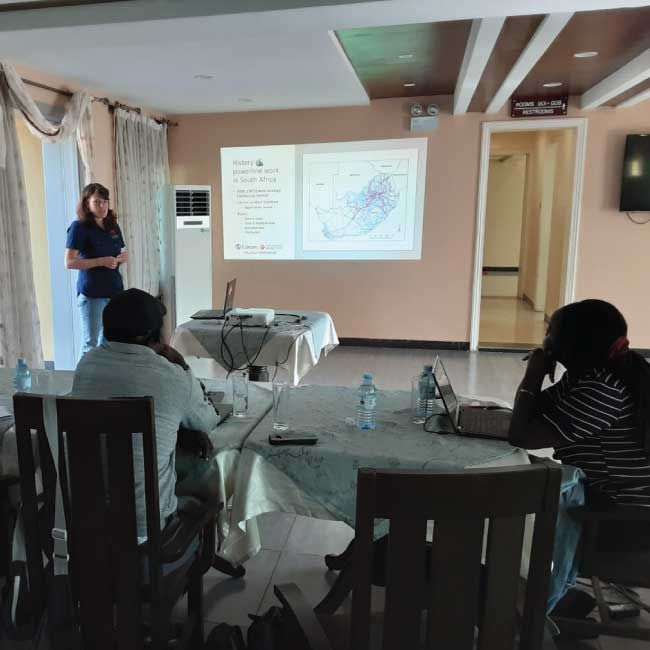Addressing the impacts of power lines on Grey Crowned Cranes in Lwengo
Gilbert Tayebwa (Southcentral Uganda field officer and Sarah Kugonza (Conservation Intern)
Introduction
Any bird able to fly stands a chance of colliding with above-ground power lines and being killed or electrocuted when perching or nesting on electricity structures and cables. In Lwengo and possibly other regions of Uganda, power lines pose the greatest threat to the Endangered Grey Crowned Crane’s survival. Migrating birds at night, birds flying in groups, and fast-flying and large birds like storks and raptors are particularly vulnerable to power line collisions. Electrocution from power lines has also been reported.

Grey Crowned Crane mortality beneath a power line in Lwengo, Uganda
 The percentage contribution of incidents by various electricity power line categories. The International Crane Foundation (ICF) and Endangered Wildlife Trust (EWT) Partnership’s African Crane Conservation Programme aims to find and implement preventative solutions to lessen the damage power lines have on cranes, other birds, and their surrounding ecosystems. In Lwengo, more than 21 cranes have died after flying into and perching on power wires over one year. Grey Crowned Cranes are the only crane species affected by electrocution because it is the only crane that perches and roosts in trees and on power line infrastructure. Some of these cranes are electrocuted or shocked, and as a result of the accident, they perish. To better understand the impacts of human-caused mortality on cranes in south-central Uganda, we are implementing a project to understand how power lines and associated infrastructure affects biodiversity in Lwengo. We are using various methods, including:
The percentage contribution of incidents by various electricity power line categories. The International Crane Foundation (ICF) and Endangered Wildlife Trust (EWT) Partnership’s African Crane Conservation Programme aims to find and implement preventative solutions to lessen the damage power lines have on cranes, other birds, and their surrounding ecosystems. In Lwengo, more than 21 cranes have died after flying into and perching on power wires over one year. Grey Crowned Cranes are the only crane species affected by electrocution because it is the only crane that perches and roosts in trees and on power line infrastructure. Some of these cranes are electrocuted or shocked, and as a result of the accident, they perish. To better understand the impacts of human-caused mortality on cranes in south-central Uganda, we are implementing a project to understand how power lines and associated infrastructure affects biodiversity in Lwengo. We are using various methods, including:
- Mapping the distribution pattern of Grey Crowned Crane incidents caused by power line infrastructure (key emphasis and activities have been on mapping incidents and identifying incident hotspots)
- Establishing transects for routine monitoring
- Empowering key stakeholders (especially Crane Custodians, wetland management committees, and local government leaders to identify, handle, and ethically address crane-power line incidents.
Capacity Building
Crane Custodians are local community members who voluntarily care for cranes and their wetland habitats. Currently, the ACCP in southcentral Uganda has 15 custodians in Lwengo (eight females and seven males) and 15 in Rukiga who have been vetted for engagement in power line surveys. The selection was based on gender inclusiveness.

The custodians being taught how to collect data during power line surveys.

A crane custodian, after identifying an incident and recording it
Community engagement
Meetings and hands-on-field works are being held with other stakeholders, such as the communities that live in crane power line incident hotspots, to identify incidents, disseminate information on the presence of power line threats to cranes and other birds surveying critical hotspots for power line collisions. The project team has trained the groups on various aspects, such as:
- The different ways to handle power line incident mortalities
- How to report power line mortalities (currently, the project team, crane custodians, and nearby authorities are responsible for responding)
- Power line incident identification (differentiating between a power line collision and electrocution and elaborating on the cause of the incident)
- Adherence to safety guidelines when monitoring and handling power line-related mortalities.

Community members during a field-based powerline survey in Lwengo
Most of the communities engaged are helping to disseminate information to other local communities on how and when to report power line incidents. The trainees can now spread information about the possibility of zoonotic diseases spreading to people who handle dead wildlife, such as cranes below power lines, and mobilise community members to report power line-related incidents involving cranes.
Capacity building within the project team
In June 2022, the Uganda team received one week of skills-building and enhancement sessions (in-house and field-based training). The team engaged in planning and developing powerline incidents data collection protocols and the setup of scientifically robust methods in crane mortality incidents data collection, including developing a risk assessment tool.

The EWT’s Christie Craig from South Africa training the Uganda team in Power lines
